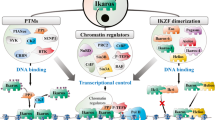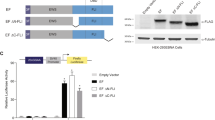Abstract
The mammalian protein DEK has been implicated in multiple cellular processes, including transcriptional regulation, mRNA processing, and chromatin remodeling, and is associated with a number of clinical autoimmune and neoplastic conditions. The connection between DEK and cancer exists at multiple levels: (a) the t(6;9) chromosomal translocation that characterizes a subtype of acute myelogenous leukemia cases results in the formation of a DEK-CAN fusion oncoprotein; (b) a fragment of dek cDNA is capable of partially reversing the radiation-sensitive phenotype of fibroblasts cultured from ataxia-telangiectasia patients; and (c) increased levels of dek mRNA have been found to be associated with hepatocellular carcinoma, glioblastoma, and melanoma. Despite the growing list of cancer subtypes with a connection to DEK, the factors that mediate its expression have yet to be characterized. Here we undertake the analysis of DEK regulation by mapping the discrete elements within the proximal promoter that are responsible for constitutive transcription of dek in transformed cells. We find that functional elements include an inverted CCAAT box and a YY1 consensus binding site, and the introduction of point mutations into these sites markedly diminishes transcriptional activity. In addition, we identify the transcriptional activator NF-Y as a member of the CCAAT-binding complex, and verify binding of the transcription factor YY1 at its consensus site in the dek promoter. The discovery of NF-Y and YY1 as regulatory determinants of DEK expression is consistent with the well-documented roles of these two factors in cellular proliferation and transformation.
This is a preview of subscription content, access via your institution
Access options
Subscribe to this journal
Receive 50 print issues and online access
$259.00 per year
only $5.18 per issue
Buy this article
- Purchase on Springer Link
- Instant access to full article PDF
Prices may be subject to local taxes which are calculated during checkout







Similar content being viewed by others
References
Alexiadis V, Waldmann T, Andersen J, Mann M, Knippers R, Gruss C . 2000 Genes Dev. 14: 1308–1312
Aravind L, Koonin E . 2000 Trends Biochem. Sci. 25: 112–114
Arnaudo J, Deibener J, Kaminsky P . 1998 J. Rheumatol. 25: 1861–1862
Dignam J, Lebovitz R, Roeder R . 1983 Nucleic Acids Res. 11: 1475–1489
Dong X, Wang J, Kabir F, Shaw M, Reed A, Stein L, Andrade L, Trevisani V, Miller M, Fujii T, Akizuki M, Pachman L, Satoh M, Reeves W . 2000 Arthritis Rheum. 43: 85–93
Donohoe M, Zhang X, McGinnis L, Biggers J, Li E, Shi Y . 1999 Mol. Cell. Biol. 19: 7237–7244
Duan Z, Stamatoyannopoulos G, Li Q . 2001 Mol. Cell. Biol. 21: 3083–3095
Faulkner N, Hilfinger J, Markovitz D . 2001 J. Biol. Chem. 276: 25804–25812
Flanagan J . 1995 Cell Growth Differ. 6: 185–190
Fornerod M, Boer J, van Baal S, Jaegle M, von Lindern M, Murti K, Davis D, Bonten J, Buijs A, Grosveld G . 1995 Oncogene 10: 1739–1748
Fu G, Grosveld G, Markovitz D . 1997 Proc. Natl. Acad. Sci. USA 94: 1811–1815
Grottke C, Mantwill K, Dietal M, Schadendorf D, Lage H . 2000 Int. J. Cancer 88: 535–546
Heinemeyer T, Wingender E, Reuter I, Hermjakob H, Kel A, Kel O, Ignatieva E, Ananko E, Podkolodnaya O, Kolpakov F, Podkolodny N, Kolchanov N . 1998 Nucleic Acids Res. 26: 362–367
Hu Q, Maity S . 2000 J. Biol. Chem. 275: 4435–4444
Kondoh N, Wakatsuki T, Ryo A, Hada A, Aihara T, Horiuchi S, Goseki N, Matsubara O, Takenaka K, Shichita M, Tanaka K, Shuda M, Yamamoto M . 1999 Cancer Res. 59: 4990–4996
Kroes R, Jastrow A, McLone M, Yamamoto H, Colley P, Kersey D, Yong V, Mkrdichian E, Cerullo L, Leestma J, Moskal J . 2000 Cancer Lett. 156: 191–198
Le Hir H, Izaurralde E, Maquat L, Moore M . 2000 EMBO J. 19: 6860–6869
Le Hir H, Gatfield D, Izaurralde E, Moore M . 2001 EMBO J. 20: 4987–4997
Li X, Hooft van Huijsduijnen R, Mantovani R, Benoist C, Mathis D . 1992 J. Biol. Chem. 267: 8984–8990
Mantovani R . 1998 Nucleic Acids Res. 26: 1135–1143
Mantovani R . 1999 Gene 239: 15–27
McGarvey T, Rosonina E, McCracken S, Li Q, Arnaout R, Mientjes E, Nickerson J, Awre D, Greenblatt J, Grosveld G, Blencowe B . 2000 J. Cell Biol. 150: 309–320
Meyn M, Lu-Kuo J, Herzing L . 1993 Am. J. Hum. Genet. 53: 1206–1216
Minuzzo M, Marchina S, Broggini M, Faircloth G, d'Incalci M, Mantovani R . 2000 Proc. Natl. Acad. Sci. USA 97: 6780–6784
Murray K, Szer W, Grom A, Donnelly P, Levinson J, Giannini E, Glass D, Szer I . 1997 J. Rheumatol. 24: 560–567
Petkova V, Romanowski M, Sulijoadikusumo I, Rohne D, Kang P, Shenk T, Usheva A . 2001 J. Biol. Chem. 276: 7932–7936
Shi Y, Lee J, Galvin K . 1997 Biochim. Biophys. Acta 1332: F49–F66
Shrivastava A, Calame K . 1994 Nucleic Acids Res. 22: 5151–5155
Sierakowska H, Williams K, Szer I, Szer W . 1993 Clin. Exp. Immunol. 94: 435–439
Tanaka H, Ohshima N, Hidaka H . 1999 Mol. Pharmacol. 55: 356–363
von Lindern M, Fornerod M, van Baal S, Jaegle M, de Wit T, Buijs A, Grosveld G . 1992 Mol. Cell. Biol. 12: 1687–1697
Zhou Y, Lee A . 1998 J. Natl. Cancer Inst. 90: 381–388
Acknowledgements
This work was supported by grants to DM Markovitz from the National Institutes of Health (AI 36685), the American Cancer Society and the Arthritis Foundation. KV Sitwala was supported in part by the National Institutes of Health training grant T32 GM07863 through the University of Michigan Medical Scientist Training Program.
Author information
Authors and Affiliations
Corresponding author
Rights and permissions
About this article
Cite this article
Sitwala, K., Adams, K. & Markovitz, D. YY1 and NF-Y binding sites regulate the transcriptional activity of the dek and dek-can promoter. Oncogene 21, 8862–8870 (2002). https://doi.org/10.1038/sj.onc.1206041
Received:
Revised:
Accepted:
Published:
Issue Date:
DOI: https://doi.org/10.1038/sj.onc.1206041
Keywords
This article is cited by
-
G9a regulates breast cancer growth by modulating iron homeostasis through the repression of ferroxidase hephaestin
Nature Communications (2017)
-
The DEK oncoprotein and its emerging roles in gene regulation
Leukemia (2015)
-
DEK promotes HPV-positive and -negative head and neck cancer cell proliferation
Oncogene (2015)
-
The DEK oncoprotein binds to highly and ubiquitously expressed genes with a dual role in their transcriptional regulation
Molecular Cancer (2014)
-
DEK over expression as an independent biomarker for poor prognosis in colorectal cancer
BMC Cancer (2013)



